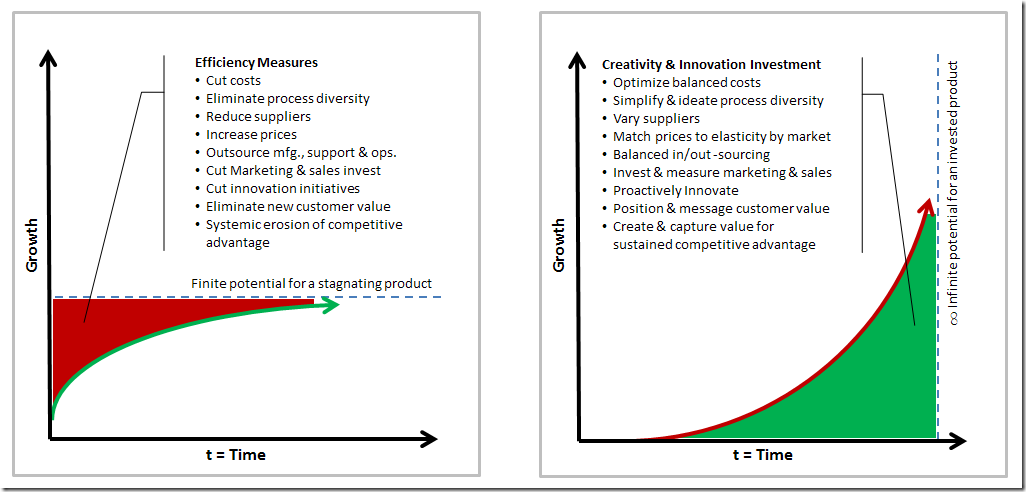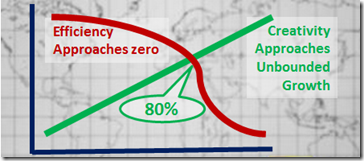 In several of my blog posts last year, I stated that creativity and innovation strategy trumps efficiency measures. And that a balance is required in many situations. It’s a simple concept, and the following two maximum asymptotic charts model their potential. The comparison also demonstrate a conflict between the two approaches.
In several of my blog posts last year, I stated that creativity and innovation strategy trumps efficiency measures. And that a balance is required in many situations. It’s a simple concept, and the following two maximum asymptotic charts model their potential. The comparison also demonstrate a conflict between the two approaches.
In the many excellent sources of information and arguments for management in times of economic pressure, or investing in creativity and innovation, my simple model and comparison appears to be unique.
In terms of leadership, applying the 80/20 rule to balance each of these may best maximize potential. And, if done well, could be the strategy to ensure growth in the long term, while weathering the storm in the short term.
Why Innovation Trumps Efficiency Now?
The primary reason this topic is on point is the global economy. The Kauffman Foundation has research that shows that the only way forward is to innovate, and accelerate new firm creation. [Added to this post on 09 Jan 2012: Link to “The Importance of Startups in Job Creation and Job Destruction.”] The 2010 Kauffman research (and basic math) shows that no amount of budget cutting, or efficiency measures in all existing corporate entities combined can create and capture enough value required to bring the world’s economies back to normal.
The past and how we got here is less important than understanding the macro economics of the two approaches. The intent is to share a visual that shows clearly how we must think, as we move forward in time.
The Diagram
Efficiency Measures Flatten Growth
From the figure on the above left, efficiency measures for a product or service have a certain amount of waste that can be squeezed out. The model fits aggregate product/service lines as well. Every MBA / business school graduate has been trained to focus here.
If under economic pressure, a company kills all creative measures in order to solely focus on reducing this waste, the result can be competitively disastrous as growth approaches zero. If leadership takes action to stop innovation and marketing-pursuit of new markets and focus on cutting costs alone when the economic pressures demand it, the growth potential for that company approaches a horizontal asymptote.
Switching to cost cutting, hiring freeze and layoff mode is often the knee-jerk reaction of many companies. It is often compounded by hiring more sales people to sell the same tired and declining core products. The result of this approach is to eliminate the flow of new value to customers and force products and services to stagnate. Ultimately, the new sales people will leave after their draw is over (cost with no value) and this then opens systematic irreversible erosion of any prior competitive advantage.
Creativity and Innovation Investment Creates Growth
On the other hand, as shown in the figure on the right, above, investing in innovation creates and captures new value in terms of revenue and growth. Investing in effective creative ways to market to and reach new customers, segments, global markets and industries is a path to growth.
It goes without saying that this investment must be aligned with the company’s vision and mission. Investment in creative marketing and sales initiatives must be integrated by strong leadership from the C-suite (CEO and CMO). And, it must be balanced with measures that ensure efficiency in these creative growth initiatives.
If corporate culture has institutionalized this mindset across the organization, eventually fewer cuts in down economies are required. The company further benefits by being well positioned to deliver value in up economies. Most important is that this leadership can weather the ebb and flow of economic tides over time.
Assured Failure vs. Balance
It takes guts to invest in growth when the economy indicates quarterly numbers are at risk now, and perhaps future quarters. However, the CEO that cuts costs by eliminating creativity and innovation assures an inevitable outcome if the economy does not recover.
However, the CEO that balances limited efficiency measures with a primary focus on investing in creative ways to innovate and drive new business has taken a path focused on creating value. This CEO is taking growth-focused action. She is not assured success, but can be confident that their leadership did everything possible to survive when conditions are down.
Macro Economic Perspective
From a macro economic the 80-20 rules applies. It may define where aggregate cost cutting crosses the line of the aggregate growth that creative and innovative approaches can add to a company’s bottom line for survival in a down economy.
Initial efficiency measures always show visible results, but these results decline over time as the growth asymptote is approached, and it costs more (in both cost and effort) to identify areas to optimize.
Growth is represented by a simple straight line showing the potential of aggregate growth from new products, services, markets and such.
If both approaches are taken, It’s easy to see that continual investing in revenue and growth generating initiatives produces a better outcome than efficiency measures alone.
Exception
Someone will ask “But what about Amazon, or companies like them? They are constantly driving cost cutting and efficiency measures.” Yes, true that IS their investment in innovation. They are innovating in the fundamental core of their business that creates value for their customers – shipping products on time.
Ponder Where Balance Occurs
There are always more costs to reduce and efficiency measures to apply in operations and organizations, but when do they become a burden on the organization? When do they reduce the integrity of the company, and its ability to maintain its market position? How long before it erodes creative and innovative growth efforts?
There’s no hard and fast rule, but between 70% and 80% should be invested in creating, capturing and sustaining value. And between 20% and 30% of effort should be put into efficiency measures. Why these numbers? There is more value created by the 80% that can be turned into revenue and growth. the investment in efficiency ultimately reduces growth on a return on innovation basis.
This balance no doubt varies. This is best applied consistently, in up and down economic environments. That takes C-suite and Boardroom guts.
Leave a comment and share your leadership wisdom with other readers.
Image credits: Asymptote charts my own. Aces: photo credit: ChaceofSpades via photopin cc












Hello Andrew,
Your assessment is directly in line with the age-old saying, “…you cannot save yourself into prosperity.”
Rare, are the truly out-sized gains a company achieves that come from ‘efficiency.’ They’re almost always the result of the ‘next big thing’ or similar. The next new market a company enters. The next new product line extension.
It would seem clear and common sense. Unfortunately, all too often companies go public, then are driven to chase the almighty Dollar, quarter by quarter, rather than do what’s best long term.
Good piece,
JT…
[…] Investing in strategic Innovation trumps efficiency measures by increasing growth potential and avoiding value stagnation, diminishing returns & zero growth (From Archives: Tip for 2013 – Strategic Innovation Trumps Efficiency Measures […]
[…] Investing in strategic Innovation trumps efficiency measures by increasing growth potential and avoiding value stagnation, diminishing returns & zero growth […]
Very good article. Whether its the US or the rest of the world, we need to efficiently deploy strategic innovation in just about every corner of civilization imaginable.
I’m working on a definition of strategic innovation and will share that soon. It only makes sense that if innovation needs strategy for direction… and good strategy is open to innovation influence… then strategic innovation exists. But what is it?
Thank you Grant, and I am excited about your defining the term Strategic Innovation. I think we may know what it is when we see it – but it’s difficult to talk about in a common vernacular if we rely on this “gut” definition. To have a good formal definition is a path that ensures we’re all using the same language. Looking forward to it.